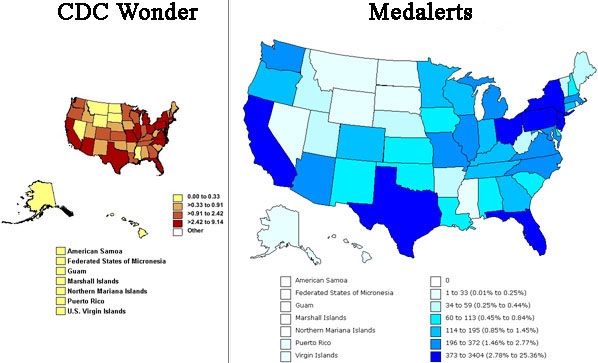
Information Center
Your Health. Your Family. Your Choice.
 |
National Vaccine Information Center Your Health. Your Family. Your Choice. |
The MedAlerts Blog |
People ask what is the difference between the MedAlerts search engine and the official U.S. Government's search engine, called CDC Wonder (Wide-ranging Online Data for Epidemiologic Research). This month we will examine and compare them. Both search engines use data from VAERS, a joint project between the FDA and the CDC. VAERS records look something like this:
|
The Advantages of CDC Wonder Often More Up To Date. As I mentioned, Wonder is typically more up-to-date than MedAlerts because of the frequency with which they update it. Primary/Secondary report distinction. Wonder shows secondary reports (VAERS reports that are follow-ups to the primary report). Secondary reports are not included in the downloaded data used to build MedAlerts. It is not known whether the information is missing from MedAlerts or is somehow combined into the primary reports. General Purpose. One interesting aspect of Wonder is that it is a general-purpose search engine which can handle much more information than just Vaccine data. For example, the CDC uses it to report AIDS, Cancer, Tuburculosis, etc.
The Advantages of MedAlerts (Full-disclosure: I wrote the MedAlerts website, so clearly I find it superior.) MedAlerts has a better user interface. The site includes popup help messages and a help page with examples. An "Expert Mode" for power users offers many advanced features including the ability to program your own searches. MedAlerts has a more powerful search engine. It can look for information in any of the fields of a VAERS event, whereas Wonder cannot. For example, Wonder cannot search for a Vaccine lot, dose, route, or site, nor can it search in any of the descriptive fields such as write-up, previous conditions, or previous medications. Besides letting you search all fields, MedAlerts also lets you search related information that is not directly in the database. For example in addition to searching for specific symptoms, you can search for high-level classes of symptoms because MedAlerts understands symptom hierarchy (as defined by MedDRA). MedAlerts has a more powerful reporting facility. Both MedAlerts and Wonder can generate Tables and Graphs from their search results, but MedAlerts has more tools for organizing these reports. Only MedAlerts lets you organize results by vaccination route or site, and by all of the event dates. In addition, MedAlerts lets you report according to useful combinations of data, for example the combination of vaccine and manufacturer. MedAlerts has better mapping. The Wonder map is tiny and shows only 5 gradations in its coloration whereas the MedAlerts map is larger and shows 7 gradations.

A Minor Flaw in Wonder Besides all of the disadvantages of CDC Wonder described so far, there is one other problem with Wonder that causes its searches to be incorrect by almost 10%!
Both MedAlerts and Wonder have similar search forms that let you choose which VAERS events you want to see. Each of the fields in the form controls the search by limiting it to certain values (for example, a vaccine, a symptom, a range of dates, etc.). At MedAlerts, all of the search fields start in the "off" position, causing the includsion every vaccine, any symptom, and all dates. At Wonder, most of the search fields start in the "off" position, except for one.
The problem appears in Section 5 of Wonder, where the default selection of State/Territory is set to "The United States, Territories, and Unknown." This excludes the foreign data, a large piece of the VAERS database. Some would argue that the foreign data is far from complete and that VAERS is primarily a US database. But there is real information here that naive users will not see if they do simple searches.
How much data is lost? See for yourself. Click "Send" at Wonder (without making any other selections) and you will get 302,920 VAERS events. Now change "The United States" to "All Locations" and you will get 328,453 events. So Wonder supresses over 25,000 events, nearly 10% of the database, by default.
<< 1/2010: Yearly wrapup 3/2010: Flu-related VAERS events and age >>
Copyright ©
2026 National Vaccine Information Center. All rights reserved.
21525 Ridgetop Circle, Suite 100, Sterling, VA 20166